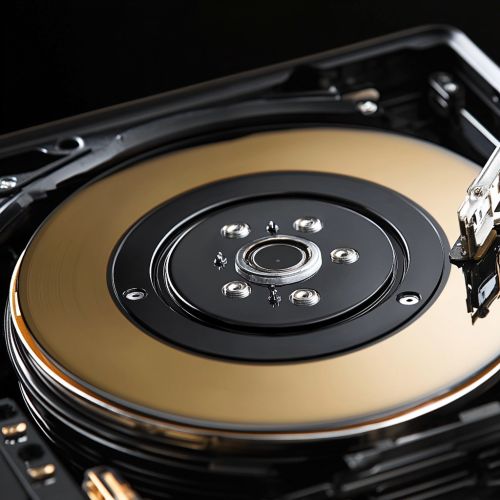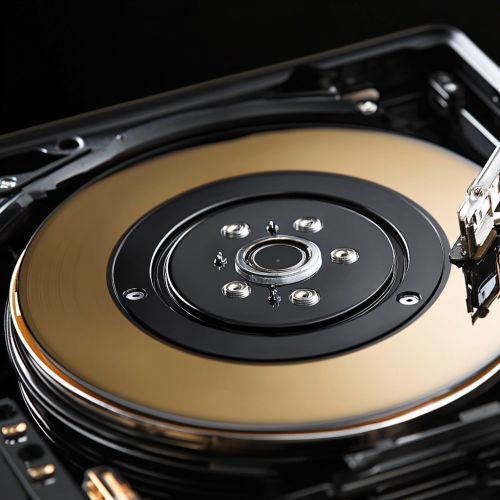Hard Drives and Storage Devices
Introduction
Hard drives and storage devices are critical components in modern computing systems, serving as the primary means of storing and retrieving digital information. This article delves into the various types of storage devices, their technological underpinnings, and their applications.
Types of Storage Devices
Storage devices can be broadly categorized into several types, each with unique characteristics and use cases.
Hard Disk Drives (HDDs)
Hard Disk Drives (HDDs) are a type of non-volatile storage that use magnetic storage to store and retrieve digital data. They consist of one or more rigid rapidly rotating disks (platters) coated with magnetic material. Data is read from and written to the platters using magnetic heads, which are positioned on an actuator arm.


HDDs are known for their large storage capacities and relatively low cost per gigabyte. They are commonly used in desktop computers, laptops, and servers.
Solid State Drives (SSDs)
Solid State Drives (SSDs) are storage devices that use integrated circuit assemblies to store data persistently, typically using flash memory. Unlike HDDs, SSDs have no moving parts, which makes them faster, more reliable, and less prone to mechanical failure.
SSDs are available in various form factors, including the traditional 2.5-inch size, M.2, and PCIe-based drives. They are widely used in modern laptops, desktops, and high-performance servers.
Hybrid Drives
Hybrid drives, also known as Solid State Hybrid Drives (SSHDs), combine the features of HDDs and SSDs. They use a small amount of high-speed flash memory to cache frequently accessed data, while the bulk of the data is stored on the magnetic platters. This approach aims to provide a balance between performance and storage capacity.
Optical Storage
Optical storage devices use laser technology to read and write data. Common types include CDs, DVDs, and Blu-ray discs. These media are often used for distributing software, movies, and music, as well as for data backup and archival purposes.
Flash Drives
Flash drives, also known as USB drives or thumb drives, are portable storage devices that use flash memory. They are widely used for transferring data between computers and for temporary storage. Flash drives are known for their small size, ease of use, and compatibility with various devices.
Network Attached Storage (NAS)
Network Attached Storage (NAS) devices are dedicated file storage units connected to a network, allowing multiple users and heterogeneous client devices to retrieve data from centralized disk capacity. NAS devices are popular in both home and enterprise environments for data sharing and backup.
Cloud Storage
Cloud storage refers to a model of data storage where digital data is stored in logical pools across multiple servers, often hosted by third-party providers. Users access cloud storage over the internet, which allows for scalable and flexible storage solutions. Popular cloud storage services include Google Drive, Dropbox, and Amazon S3.
Technological Underpinnings
Understanding the technology behind storage devices provides insight into their performance, reliability, and use cases.
Magnetic Storage
Magnetic storage, used in HDDs, relies on the magnetization of a ferromagnetic material to store data. The read/write heads alter the magnetic fields on the platters to encode data. The density of data storage is determined by the size of the magnetic domains and the precision of the read/write heads.
Flash Memory
Flash memory, used in SSDs and flash drives, is a type of non-volatile memory that can be electrically erased and reprogrammed. It is based on floating-gate transistors, which can hold an electrical charge for extended periods, thus retaining data even when the power is off.
Optical Storage
Optical storage uses lasers to read and write data on discs. The data is encoded in the form of pits and lands on the surface of the disc. The laser beam reflects differently off the pits and lands, allowing the optical drive to interpret the data.
RAID Technology
Redundant Array of Independent Disks (RAID) is a data storage virtualization technology that combines multiple physical disk drives into one or more logical units for redundancy, performance improvement, or both. RAID levels include RAID 0 (striping), RAID 1 (mirroring), RAID 5 (striping with parity), and RAID 6 (striping with double parity).
Applications
Storage devices are used in various applications, each with specific requirements for performance, capacity, and reliability.
Personal Computing
In personal computing, storage devices are used to store operating systems, applications, and user data. HDDs and SSDs are the most common storage devices in this domain, with SSDs gaining popularity due to their superior performance.
Enterprise Storage
Enterprise storage solutions often involve large-scale storage systems designed for high availability, scalability, and performance. These systems may include SAN (Storage Area Network) and NAS configurations, as well as cloud storage solutions.
Data Centers
Data centers require robust and scalable storage solutions to handle vast amounts of data. They often use a combination of HDDs, SSDs, and cloud storage to meet their needs. RAID configurations and data redundancy are critical for ensuring data integrity and availability.
Backup and Archival
Backup and archival storage solutions are designed to protect data from loss and to store data for long-term retention. Optical media, tape drives, and cloud storage are commonly used for these purposes.
Future Trends
The field of storage technology is continually evolving, with several emerging trends shaping the future of data storage.
Non-Volatile Memory Express (NVMe)
NVMe is a storage protocol designed for high-speed SSDs. It provides faster data transfer speeds and lower latency compared to traditional storage protocols like SATA. NVMe is becoming the standard for high-performance storage solutions.
3D NAND Technology
3D NAND technology involves stacking layers of memory cells vertically to increase storage density and reduce cost per gigabyte. This technology is widely used in modern SSDs and is expected to continue advancing.
Storage Class Memory (SCM)
Storage Class Memory (SCM) is a new category of memory that combines the speed of DRAM with the persistence of NAND flash. SCM technologies, such as Intel Optane, offer significant performance improvements for certain applications.
DNA Data Storage
DNA data storage is an experimental technology that uses synthetic DNA to store data. It has the potential to offer extremely high storage densities and long-term data retention. While still in the research phase, DNA data storage could revolutionize the field of data storage in the future.
